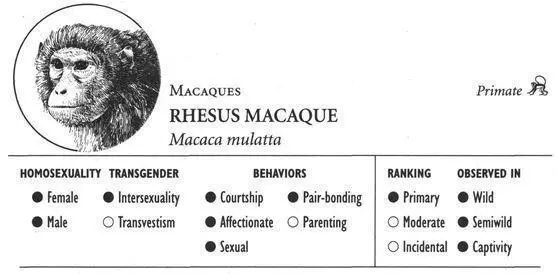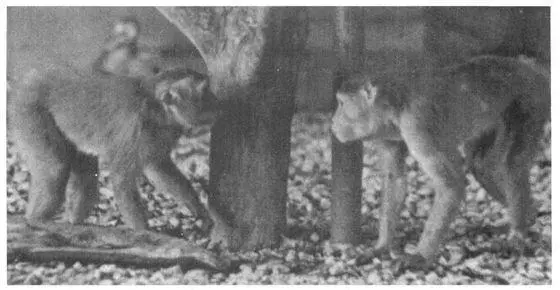Itani, J. (1959) “Paternal Care in the Wild Japanese Monkey, Macaca fuscata fuscata.” Primates 2:61–93.
*Lunardini, A. (1989) “Social Organization in a Confined Group of Japanese Macaques ( Macaca fuscata ) . An Application of Correspondence Analysis.” Primates 30:175–85.
*Rendall, D., and L. L. Taylor (1991) “Female Sexual Behavior in the Absence of Male-Male Competition in Captive Japanese Macaques ( Macaca fuscata ).” Zoo Biology 10:319–28.
*Sugiyama, Y. (1960) “On the Division of a Natural Troop of Japanese Monkeys at Takasakiyama.” Primates 2:109–48.
*Takahata, Y. (1982) “The Socio-sexual Behavior of Japanese Monkeys.” Zeitschrift für Tierpsychologie 59:89–108.
*———(1980) “The Reproductive Biology of a Free-Ranging Troop of Japanese Monkeys.” Primates 21:303–29.
Takahata, Y., N. Koyama, and S. Suzuki (1995) “Do the Old Aged Females Experience a Long Postreproductive Life Span?: The Cases of Japanese Macaques and Chimpanzees.” Primates 36:169–80.
*Tartabini, A. (1978) “An Analysis of Dyadic Interactions of Male Japanese Monkeys ( Macaca fuscata fuscata ) in a Cage-Room Observation.” Primates 19:423–36.
Tokuda, K. (1961) “A Study on the Sexual Behavior in the Japanese Monkey Troop.” Primates 3:1–40.
*Vasey, P. L (1998) “Female Choice and Inter-sexual Competition for Female Sexual Partners in Japanese Macaques.” Behavior 135:1–19.
*———(1996–98) Personal communication.
*———(1996) “Interventions and Alliance Formation Between Female Japanese Macaques, Macaca fuscata , During Homosexual Consortships.” Animal Behavior 52:539–51.
*Vasey, P. L., B. Chapais, and C. Gauthier (1998) “Mounting Interactions Between Female Japanese Macaques: Testing the Influence of Dominance and Aggression.” Ethology 104:387–98.
*Wolfe, L. D. (1986) “Sexual Strategies of Female Japanese Macaques ( Macaca fuscata ).” Human Evolution 1:267–75.
*———(1984) “Japanese Macaque Female Sexual Behavior: A Comparison of Arashiyama East and West.” In M. F. Small, ed., Female Primates: Studies by Women Primatologists , pp. 141–58. New York: Alan R. Liss.
*———(1979) “Behavioral Patterns of Estrous Females of the Arashiyama West Troop of Japanese Macaques ( Macaca fuscata ).” Primates 20:525–34.
*Wolfe, L. D., and M. J. S. Noyes (1981) “Reproductive Senescence Among Female Japanese Macaques ( Macaca fuscata fuscata ).” Journal of Mammology 62:698–705.

IDENTIFICATION: A brown monkey with a pale reddish face and rump, and a medium-sized tail (up to I foot long). DISTRIBUTION: Afghanistan, India, southern China, northern Southeast Asia. HABITAT: Variable, including semidesert, forests, swamps. STUDY AREAS: Wild: near Dehra Dun, India; semiwild: Cayo Santiago Island, Puerto Rico; captivity: Caribbean Primate Research Center, Sabana Seca, Puerto Rico; California, Tulane, Wisconsin, and Yerkes Regional Primate Research Centers; and other locations.
Social Organization
Rhesus Macaques live in troops numbering up to 80–100 individuals. These are composed of several cosexual subgroups (averaging around 18 members) organized along matrilineal kinship. Males typically leave their subgroup during adolescence and establish themselves elsewhere—sometimes in all-male groups—leaving the female line of descent intact.
Description
Behavioral Expression: In female Rhesus Macaques, homosexual behavior usually takes place in a CONSORTSHIP, a type of pair-bond between two females that can last anywhere from a few days to many months (consortships are also characteristic of heterosexual relations). Two consorts follow and spend a great deal of time with each other, and participate in a wide variety of courtship, affectionate, and sexual activities; consort partners also sometimes cooperate in attacking other individuals. Females might consort with several other females, although most have only one partner. Lesbian courtship is highly distinctive, and involves five different playful pursuit games: “hide-and-seek,” in which two females peek at each other from around a tree trunk; “kiss and run,” in which one female rushes up to another and briefly kisses or nuzzles her before running off, the other in pursuit; “follow the leader,” in which the females alternate positions following one another; “lipsmack and circle,” where one female circles closer and closer to the other while making lip-smacking noises; and “present and run,” where one female invites the other to mount her and then teasingly runs off.
Courtship between two female Rhesus Macaques: a game of “hide-and-seek”

Sexual activity usually involves one female mounting the other, either in the position used for heterosexual mounting (with the mounter’s feet on the mountee’s legs), or in a position unique to homosexual mounting, in which one female climbs directly on the back of the other female and rubs her genitals on the mountee’s rump. Mounting from the side also occurs. The mounter sometimes stimulates her clitoris or has her partner do it for her, during a mount. Both females show signs of orgasm: the mounter often “pauses” the way a male does at the moment of ejaculation, while the mountee often reaches back and clutches her partner. In some consortships the two females mount each other reciprocally, although in many cases one female is consistently the mounter and her partner always the mountee. Sometimes two females also participate in sexual hugging, in which they wrap their arms and legs around each other while one or both of them engage in clitoral stimulation (including rubbing their genitals on the ground). Combined with sexual stimulation, females also kiss (touching lips or tongues), caress each other’s face, gently bite one another’s ears, and groom each other. Pregnant females sometimes participate in homosexual mounting and consortships as well. Occasionally, females behave aggressively toward a female sexual partner, as also seen in heterosexual interactions (see below).
Male Rhesus Macaques also mount each other, sometimes within a consortship as well. Mounting can include full anal penetration and ejaculation, or else simple thrusting against the partner. Sometimes the mounted male masturbates himself or his partner, and reciprocal mounting is also common (in which the two males take turns mounting each other). In some cases, one male performs a series of mounts one after the other on his partner, as in heterosexual mating. Homosexual activity may be accompanied by grooming or play-wrestling, and the two partners in a consortship can be highly affectionate toward each other, with extended periods of touching, holding, and embracing. Mounting between brothers has also been observed, as well as with males of other species such as Crab-eating Macaques (in captivity).
Several types of intersexuality occur spontaneously in Rhesus Macaques, including hermaphrodite monkeys whose internal gonads are a combination of ovaries and testes, as well as individuals that have female external genitalia but are missing a female sex chromosome and have no ovaries.
Frequency: In wild and semiwild populations of Rhesus Macaques, anywhere from 16 percent to 47 percent of mounting is between animals of the same sex; the majority of homosexual mounting (84 percent) is between males. Within a lesbian consortship, two females may mount each other more than 200 times over six months, and one couple participated in homosexual mounting more than 1,000 times during that time.
Читать дальше














